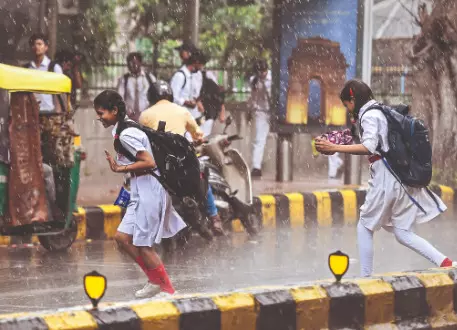Monsoon likely to cover Delhi by June 22

New Delhi: The southwest monsoon, which rapidly covered large parts of central, western and eastern India over the last two days, is expected to reach Delhi and some parts of Haryana and Punjab in the next two to three days.
The India Meteorological Department’s (IMD) extended-range-model guidance predicts rainfall over large parts of northwest India, including Haryana, Punjab, Chandigarh, Delhi, Himachal Pradesh, Uttar Pradesh, east Rajasthan, Jammu and Kashmir and Ladakh, between June 20 and June 25.
An IMD official confirmed that the system is likely to reach Delhi by June 22, ahead of the normal onset date of June 30.
According to the weather department’s extended-range forecast, the primary rain-bearing system will cover the remaining parts of the country in the following week, well ahead of the usual dates.
The primary rain-bearing system reached Kerala on May 24, marking its earliest onset over the Indian mainland since 2009, when it arrived on May 23.
Aided by strong low-pressure systems over the Arabian Sea and the Bay of Bengal, monsoon advanced quickly over the next few days, covering parts up to central Maharashtra, including Mumbai, and the entire northeast by May 29.
However, this was followed by a prolonged stagnation of around 18 days, from May 29 to June 16.
The lack of rainfall since early June led to a sharp rise in temperatures, triggering heatwave conditions across large parts of northwest and central India since June 8-9.
Monsoon advanced quickly from June 16 to June 18 due to two low-pressure systems forming on June 17 -- one over West Bengal and the other over Gujarat.
The rain system usually makes its onset over Kerala by June 1, reaches Mumbai by June 11 and covers the entire country by July 8. It starts retreating from northwest India around September 17 and withdraws completely by October 15.
Meteorologists say the date of monsoon onset does not directly correlate with the total seasonal rainfall. An early or delayed arrival in Kerala or Mumbai does not necessarily indicate similar progress in other parts of the country.
They say monsoon is influenced by complex global, regional and local factors, and is marked by significant variability.
In May, the IMD had forecast that India was likely to receive 106 per cent of the long-period average (LPA) rainfall of 87 cm during the June-September monsoon season. Rainfall between 96 per cent and 104 per cent of this 50-year average is considered “normal”. Above-normal rainfall is expected in most parts of the country, except Ladakh, adjoining areas of Himachal Pradesh, the northeast and some parts of Bihar, Jharkhand, West Bengal and Odisha. Some isolated areas in Punjab, Haryana, Kerala and Tamil Nadu may record below-normal rainfall. Monsoon is crucial for India’s agriculture sector, which supports the livelihood of around 42 per cent of the population and contributes 18.2 per cent to the GDP. It also plays a key role in replenishing the reservoirs essential for drinking water and power generation.with agency inputs



